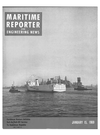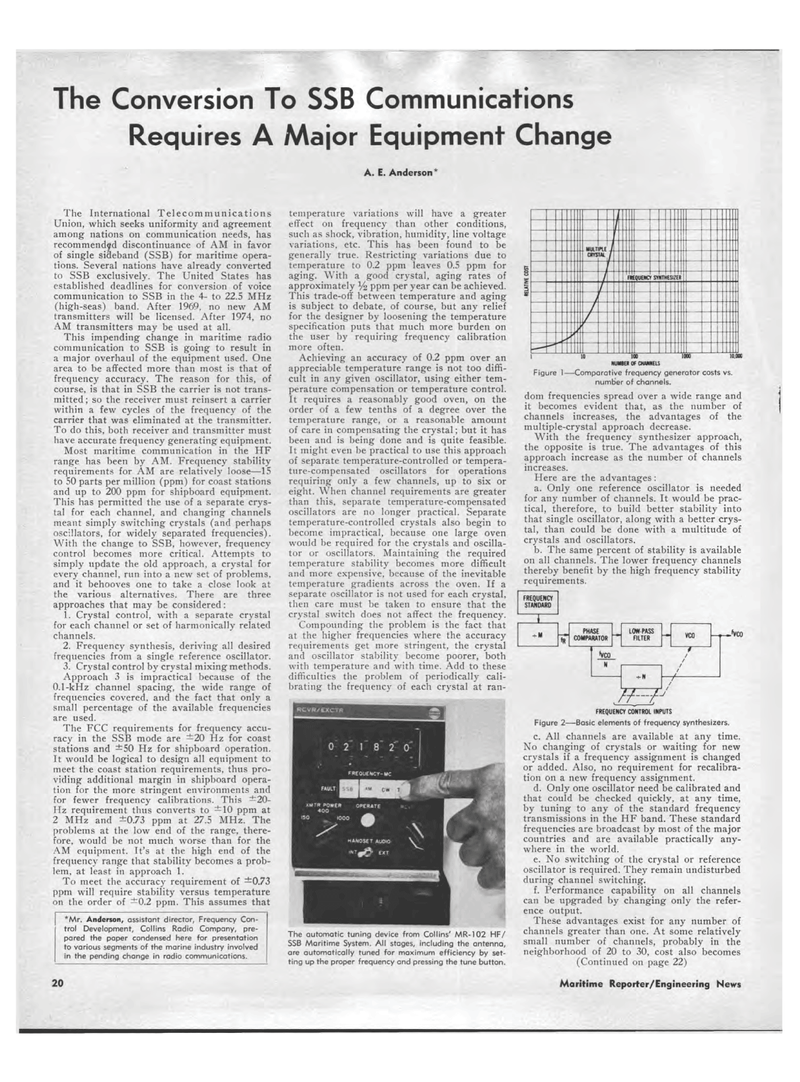
Page 18: of Maritime Reporter Magazine (January 15, 1969)
Read this page in Pdf, Flash or Html5 edition of January 15, 1969 Maritime Reporter Magazine
The Conversion To SSB Communications Requires A Major Equipment Change A. E. Anderson* The International Telecommunications Union, which seeks uniformity and agreement among nations on communication needs, has recommended discontinuance of AM in favor of single sideband (SSB) for maritime opera-tions. Several nations have already converted to SSB exclusively. The United States has established deadlines for conversion of voice communication to SSB in the 4- to 22.5 MHz (high-seas) band. After 1969, no new AM transmitters will be licensed. After 1974, no AM transmitters may be used at all. This impending change in maritime radio communication to SSB is going to result in a major overhaul of the equipment used. One area to be affected more than most is that of frequency accuracy. The reason for this, of course, is that in SSB the carrier is not trans-mitted ; so the receiver must reinsert a carrier within a few cycles of the frequency of the carrier that was eliminated at the transmitter. To do this, both receiver and transmitter must have accurate frequency generating equipment. Most maritime communication in the HF range has been by AM. Frequency stability requirements for AM are relatively loose?15 to 50 parts per million (ppm) for coast stations and up to 200 ppm for shipboard equipment. This has permitted the use of a separate crys-tal for each channel, and changing channels meant simply switching crystals (and perhaps oscillators, for widely separated frequencies). With the change to SSB, however, frequency control becomes more critical. Attempts to simply update the old approach, a crystal for every channel, run into a new set of problems, and it behooves one to take a close look at the various alternatives. There are three approaches that may be considered: 1. Crystal control, with a separate crystal for each channel or set of harmonically related channels. 2. Frequency synthesis, deriving all desired frequencies from a single reference oscillator. 3. Crystal control by crystal mixing methods. Approach 3 is impractical because of the 0.1-kHz channel spacing, the wide range of frequencies covered, and the fact that only a small percentage of the available frequencies are used. The FCC requirements for frequency accu-racy in the SSB mode are ±20 Hz for coast stations and ±50 Hz for shipboard operation. It would be logical to design all equipment to meet the coast station requirements, thus pro-viding additional margin in shipboard opera-tion for the more stringent environments and for fewer frequency calibrations. This ±20-Hz requirement thus converts to ?10 ppm at 2 MHz and ±0.73 ppm at 27.5 MHz. The problems at the low end of the range, there-fore, would be not much worse than for the AM equipment. It's at the high end of the frequency range that stability becomes a prob-lem, at least in approach 1. To meet the accuracy requirement of ?0.73 ppm will require stability versus temperature on the order of ?0.2 ppm. This assumes that *Mr. Anderson, assistant director, Frequency Con-trol Development, Collins Radio Company, pre-pared the paper condensed here for presentation to various segments of the marine industry involved in the pending change in radio communications. temperature variations will have a greater effect on frequency than other conditions, such as shock, vibration, humidity, line voltage variations, etc. This has been found to be generally true. Restricting variations due to temperature to 0.2 ppm leaves 0.5 ppm for aging. With a good crystal, aging rates of approximately % ppm per year can be achieved. This trade-off between temperature and aging is subject to debate, of course, but any relief for the designer by loosening the temperature specification puts that much more burden on the user by requiring frequency calibration more often. Achieving an accuracy of 0.2 ppm over an appreciable temperature range is not too diffi-cult in any given oscillator, using either tem-perature compensation or temperature control. It requires a reasonably good oven, on the order of a few tenths of a degree over the temperature range, or a reasonable amount of care in compensating the crystal; but it has been and is being done and is quite feasible. It might even be practical to use this approach of separate temperature-controlled or tempera-ture-compensated oscillators for operations requiring only a few channels, up to six or eight. When channel requirements are greater than this, separate temperature-compensated oscillators are no longer practical. Separate temperature-controlled crystals also begin to become impractical, because one large oven would be required for the crystals and oscilla-tor or oscillators. Maintaining the required temperature stability becomes more difficult and more expensive, because of the inevitable temperature gradients across the oven. If a separate oscillator is not used for each crystal, then care must be taken to ensure that the crystal switch does not affect the frequency. Compounding the problem is the fact that at the higher frequencies where the accuracy requirements get more stringent, the crystal and oscillator stability become poorer, both with temperature and with time. Add to these difficulties the problem of periodically cali-brating the frequency of each crystal at ran-RCVR/EXCTR 0 2 18 2 0 FNEOUENCr-UC MULT g »MTR POWER OPERATE <00 IOOO ^fe HANDSET AUOtO ??WMM&f/i The automatic tuning device from Collins' MR-102 HF/ SSB Maritime System. All stages, including the antenna, are automatically tuned for maximum efficiency by set-ting up the proper frequency and pressing the tune button. I -MULT fIF \ -CRYS TAl / 1 / Fl 1QUENC sr ro ESIZ Eft / j J / 10 300 100 NUMEt OF CHANNELS Figure 1?Comparative frequency generator costs vs. number of channels. dom frequencies spread over a wide range and it becomes evident that, as the number of channels increases, the advantages of the multiple-crystal approach decrease. With the frequency synthesizer approach, the opposite is true. The advantages of this approach increase as the number of channels increases. Here are the advantages: a. Only one reference oscillator is needed for any number of channels. It would be prac-tical, therefore, to build better stability into that single oscillator, along with a better crys-tal, than could be done with a multitude of crystals and oscillators. b. The same percent of stability is available on all channels. The lower frequency channels thereby benefit by the high frequency stability requirements. FREQUENCY STANDARD PHASE COMPARATOR L0WPASS FILTER Vco VCO 7 _Vco 2EJJ FREQUENCY CONTROL INPUTS Figure 2?-Basic elements of frequency synthesizers. c. All channels are available at any time. No changing of crystals or waiting for new crystals if a frequency assignment is changed or added. Also, no requirement for recalibra-tion on a new frequency assignment. d. Only one oscillator need be calibrated and that could be checked quickly, at any time, by tuning to any of the standard frequency transmissions in the HF band. These standard frequencies are broadcast by most of the major countries and are available practically any-where in the world. e. No switching of the crystal or reference oscillator is required. They remain undisturbed during channel switching. f. Performance capability on all channels can be upgraded by changing only the refer-ence output. These advantages exist for any number of channels greater than one. At some relatively small number of channels, probably in the neighborhood of 20 to 30, cost also becomes (Continued on page 22) 20 Maritime Reporter/Engineering News

 17
17

 19
19
